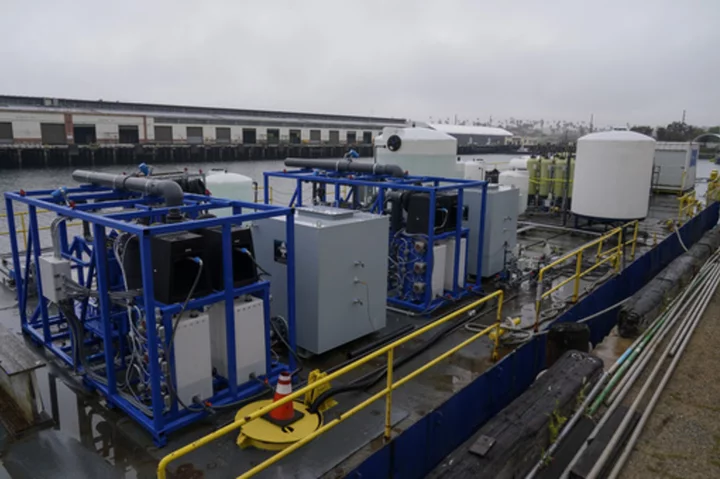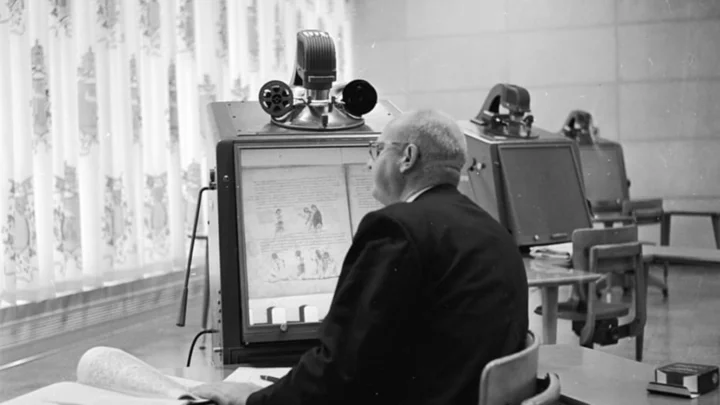
Boeing signs alternative fuel deal with Los Angeles startup to cut carbon footprint
A Los Angeles startup that is designing facilities to remove carbon dioxide from the ocean says it has struck a pre-purchase agreement with Boeing
2023-06-02 03:58

Scientists make 'shocking' discovery on Saturn's moon that could reveal signs of life
Dramatic explosions on the surface of one of Saturn's moons have been observed, and it could change the way scientists approach the search for life in the universe. Saturn's ice-covered moon Enceladus has been the subject of attention from astronomers for decades after plumes of water vapor were observed erupting from its surface 20 years ago by the Cassini spacecraft. Now, the biggest plume yet has been spotted by the James Webb Space Telescope and it measures a massive 10,000 kilometers in length. Incredibly, the plume emitting from the geyser on the surface measures 20 times the size of the moon itself, and it indicates that there’s more to Enceladus than previously thought. Sign up to our free Indy100 weekly newsletter Planetary scientist Geronimo Villanueva of NASA's Goddard Space Flight Center said: "When I was looking at the data, at first, I was thinking I had to be wrong, it was just so shocking to map a plume more than 20 times the diameter of the moon. "The plume extends far beyond what we could have imagined." Instead of solid ice, the size of the plume shows us that there’s a liquid ocean under the surface. It’s kept warm enough to avoid freezing due to the movement that results from the gravitational pull of Saturn. As ever, the existence of liquid water suggests that there’s the possibility of life existing there, and it's encouraging news for authors of the study accepted in Nature Astronomy. "The orbit of Enceladus around Saturn is relatively quick, just 33 hours. As it whips around Saturn, the moon and its jets are basically spitting off water, leaving a halo, almost like a donut, in its wake," Villanueva said. "In the Webb observations, not only was the plume huge, but there was just water absolutely everywhere." It remains one of the most interesting bodies being studied in the solar system, as geochemist Christopher Glein of the Southwest Research Institute. “Enceladus is one of the most dynamic objects in the Solar System and is a prime target in humanity's search for life beyond Earth," geochemist Christopher Glein of the Southwest Research Institute said. "In the years since NASA's Cassini spacecraft first looked at Enceladus, we never cease to be amazed by what we find is happening on this extraordinary moon." Have your say in our news democracy. Click the upvote icon at the top of the page to help raise this article through the indy100 rankings.
2023-06-01 22:26

China is digging one of the deepest ever holes and might find signs of life
China have embarked on an enormous project: to dig the biggest hole in the country. The planned 10,000 metre hole will aim to pierce through ten layers of rock and could even end up finding signs of life as suggested by discoveries in past boreholes. And the objective? To reach rocks and minerals that could date back to around 145 million years ago - or the Cretaceous period. Findings from the mission may help alert China to environmental hazards such as volcanoes and earthquakes, whilst also identifying potentially valuable minerals lurking below. Past expeditions have also unearthed signs of life - with one project discovering signs of life under the surface. Don't worry, it wasn't subterranean humans or any other horror movie tropes. That borehole unearthed plankton 4 miles below the surface. Sign up to our free Indy100 weekly newsletter That project won't be surpassed by this new - admittedly massive - attempt. The deepest ever dug - the one that discovered the plankton - was in Russia. The Kola Superdeep Borehole - just a really big hole in the ground - ended up reaching over 11,000 meters below sea level after being started by Soviet scientists in 1970. They had to abandon the project after hitting extremely high temperatures that they weren't expecting. Interesting. The Chinese project isn't going to be easy. It's not as simple as digging straight down into the Earth's crust and hoping for the best. It's also extremely costly and time-consuming. “The construction difficulty of the drilling project can be compared to a big truck driving on two thin steel cables,” Sun Jinsheng, an academic from the Chinese Academy of Engineering, told news agency Xinhua. So yeah, they'll need more than a JCB for this. Have your say in our news democracy. Click the upvote icon at the top of the page to help raise this article through the indy100 rankings.
2023-06-01 18:59

Hundreds of Amazon workers protest company's climate impact, return-to-office mandate
Hundreds of corporate Amazon workers upset about the company’s environmental impact, recent layoffs and a return-to-office mandate protested at its Seattle headquarters
2023-06-01 05:58

Before E-Readers, a 1930s Writer Reinvented the Book With “Readies”
Machines called “Readies” were writer Bob Brown’s answer to “talkies” in the 1930s.
2023-06-01 05:19

Amazon Workers Walk Out to Protest Climate, Office Return Policy
Amazon.com Inc. employees walked off the job Wednesday to protest the company’s return-to-work policies, impact on the climate
2023-06-01 03:51

Amazon workers stage walkout over company's climate impact, return-to-office mandate
A group of corporate Amazon workers upset about the company’s environmental impact, recent layoffs and a return-to-office mandate is planning a walkout at the company’s Seattle headquarters
2023-06-01 01:46

The Best Apps and Tools to Help Kids Organize Schoolwork
Most families have aspirations of starting a new school year organized and prepared for academic
2023-06-01 00:58

Nasa holds first public meeting about sightings of UFOs
Nasa has convened a public meeting to discuss sightings of unexplained phenomena in the sky. The space agency has convened a panel to examine sightings of what it calls UAPs, or unidentified aerial phenomena, which many refer to as UFOs. Now the group has given its first public discussion, ahead of a report due to be published later this year. The space agency said the work was aimed at making it easier for people to report those UAPs, as well as to examine what exactly they might be. But representatives said that the panel involved in the work had received sustained abuse that had got in the way of that work. “Harassment only leads to further stigmatisation of the UAP field, significantly hindering the scientific progress and discouraging others to study this important subject matter,” said Nicky Fox, associate administrator for NASA’s science mission directorate/ Nonetheless, Nasa said that it would be working to examine those reports of UAPs. “The presence of UAPs raises concerns about the safety of our skies, and it’s this nation’s obligation to determine if these phenomena pose any potential risks to airspace safety,” said Daniel Evans, Nasa’s assistant deputy associate administrator for research. The work is about safety but also the space agency’s “responsibility to be honest and forthright and to follow the science”, he said. But the data on UAPs has so far been “fragmented”, according to the panel’s chair, David Spergel, with problems of imprecision and having information spread across different agencies. Those issues meant that it was difficult to provide conclusions on every reported UAP event. He called for better data and joined other panelists in arguing that it should become less stigmatised for people to come forward about their sightings. Numerous panelists said that there was a “stigma” about reporting such phenomena that made it difficult to fully examine what might be going on. The 16-member panel includes experts in everything from physics to astrobiology, and began its work last June. Wednesday’s session is the first public hearings by the group – which itself represents the first such inquiry into unidentified aerial phenomena by Nasa. The NASA study is separate from a newly formalized Pentagon-based investigation of unidentified aerial phenomena, or UAPs, documented in recent years by military aviators and analyzed by U.S. defense and intelligence officials. The parallel NASA and Pentagon efforts - both undertaken with some semblance of public scrutiny - highlight a turning point for the government after decades spent deflecting, debunking and discrediting sightings of unidentified flying objects, or UFOs, dating back to the 1940s. The term UFOs, long associated with notions of flying saucers and aliens, has been replaced in government parlance by “UAP.” While NASA‘s science mission was seen by some as promising a more open-minded approach to a topic long treated as taboo by the defense establishment, the U.S. space agency made it known from the start that it was hardly leaping to any conclusions. “There is no evidence UAPs are extraterrestrial in origin,” NASA said in announcing the panel’s formation last June. In its more recent statements, the agency presented a new potential wrinkle to the UAP acronym itself, referring to it as an abbreviation for “unidentified anomalous phenomena.” This suggested that sightings other than those that appeared airborne may be included. Still, NASA in announcing Wednesday’s meeting, said the space agency defines UAPs “as observations of events in the sky that cannot be identified as aircraft or known natural phenomena from a scientific perspective.” U.S. defense officials have said the Pentagon’s recent push to investigate such sightings has led to hundreds of new reports that are under examination, though most remain categorized as unexplained. The head of the Pentagon’s newly formed All-domain Anomaly Resolution Office (AARO) has said the existence of intelligent alien life has not been ruled out but that no sighting had produced evidence of extraterrestrial origins. Additional reporting by agencies Read More Nasa says Jeff Bezos will build moon lander to take astronauts to the Moon Opinion: The real reason companies are warning that AI is as bad as nuclear war Electric car drives for 100 hours non-stop on futuristic road Opinion: The real reason companies are warning that AI is as bad as nuclear war Electric car drives for 100 hours non-stop on futuristic road US and China ‘intertwined like conjoined twins,’ says Musk
2023-05-31 23:18

Amazon corporate workers plan to stage walkout, citing 'lack of trust' in leadership
Nearly 2,000 corporate workers at Amazon have pledged to walk off the job on Wednesday to signal a "lack of trust" in the company's leadership, in what could be the most visible sign of dissent among the e-commerce giant's office workers in recent memory.
2023-05-31 23:15

Turkmenistan in Talks With US to Tackle Giant Methane Leaks
American officials are negotiating a deal to help Turkmenistan curb its vast methane emissions, potentially sealing a major
2023-05-31 23:15

AI boom triples valuation of Lightmatter, US startup using light for computing
By Jane Lanhee Lee OAKLAND, California Lightmatter, a Boston-based startup using light for AI computing, said on Wednesday
2023-05-31 22:17
